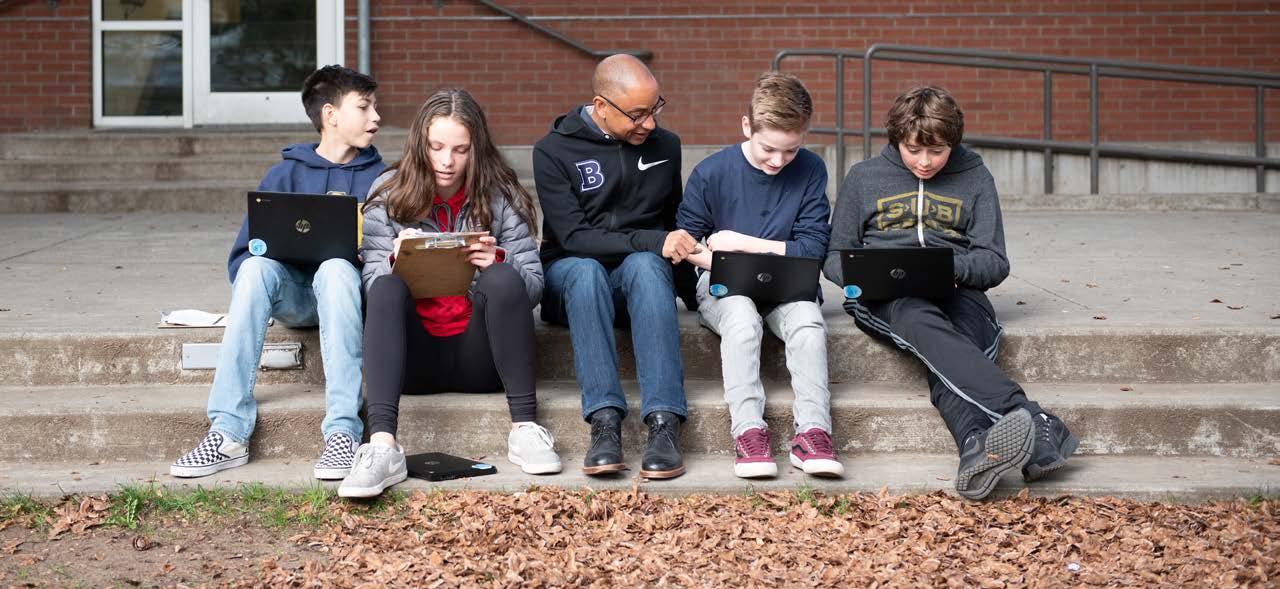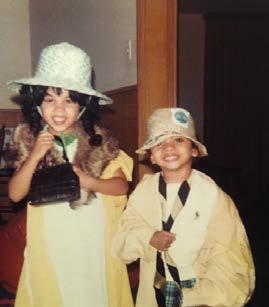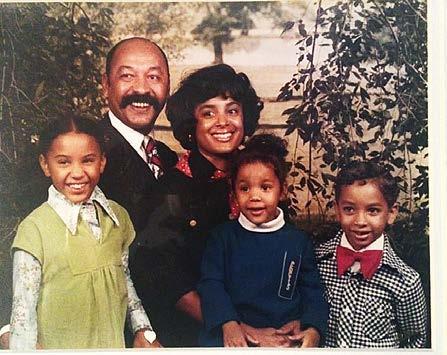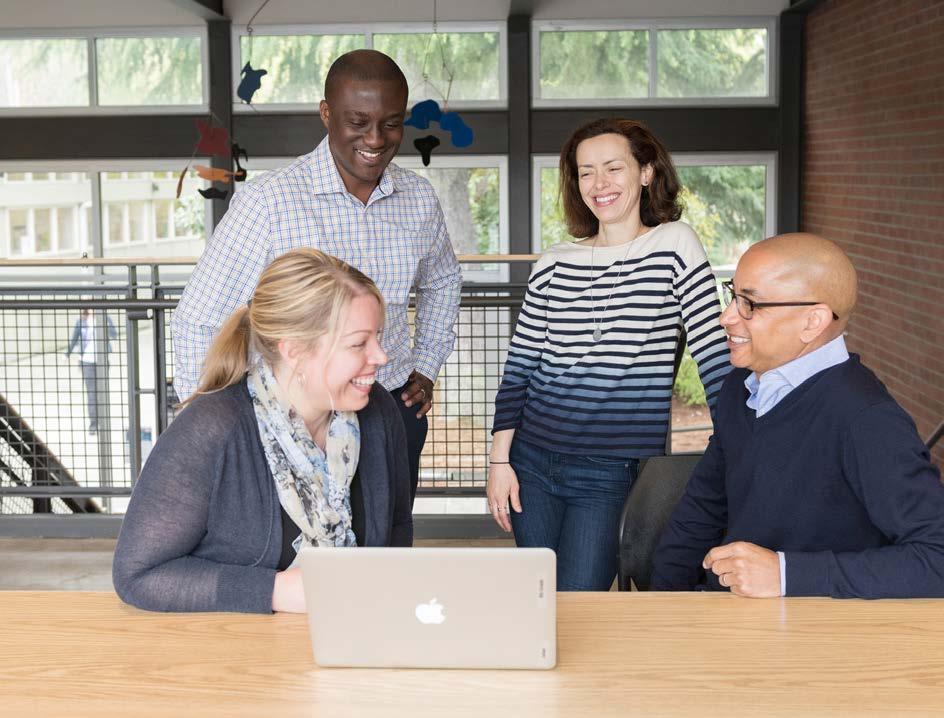
11 minute read
Bush is Remarkable
ON HOW LIFE LOOKS AFTER FIVE YEARS AS HEAD
When Head of School Percy L. Abram first stepped onto The Bush School campus, he recognized the school he had heard and read about over his nearly twodecade career of working in independent schools. He encountered a dynamic school in which engaged students were passionate about learning, and curious about the world around them. He knew immediately that, in his words, “this is the community that I want to lead, and this is the type of education that I want for my children.”
In 2014, Percy was appointed Bush’s ninth head of school, and inherited Helen Bush’s vision. “Helen said that the foundation of the school is the trust that teachers have in students. We afford our students a high level of trust at a very young age by exposing them to the wonder and complexity of the world around them. In return, this trust gives them the freedom to pursue learning earnestly and eagerly,” Percy explains. But how would Percy expand Helen Bush’s vision to meet the challenges of the twenty-first century?

While the core tenets of Helen Bush’s promise continue to be relevant, today’s world looks dramatically different. Helen knew that relationships are at the core of learning. Today, young people must learn to manage relationships across digital landscapes, as well as in person. America is becoming more ethnically and racially diverse—projected to have no single ethnic majority by around 2050—so Bush graduates, the leaders of tomorrow, must be interculturally fluent and at ease in a world that will look and feel much different than what they experience today. Percy knows that Bush today must take on the challenge of preparing young people to solve problems that don’t yet exist.

Percy believes that delivering a great progressive education is active, collaborative, and, most of all, relational. While the essence of Bush has always been in the relationships that are built between teachers and students, today research backs it up by showing that emotional relationships are at the core of great learning. “If students don’t know that you care about them—where they’re from, who they are, what they’re interested in, what they’re afraid of, where they’re insecure—then they won’t be willing to trust you,” Percy says. “I think about how powerful it is to see a child get excited about learning how to read, how impactful it is traveling to watch students at state semifinals. The time that we spend investing in and caring for our students is what makes this school so dynamic and remarkable.”
“I try not to take for granted what we’re trying to do and build here at The Bush School,” Percy says. “And I try to not take for granted the time spent with students, because that time spent together matters.” Each moment with students stays with Percy. He talks about making a connection with a student in Nancy Bowman’s United States History class, who was writing a paper on Paul Volcker’s influence on the Federal Reserve. “He was so animated and excited. Being able to engage with him on what it was like to live through that time was really affirming. As I was leaving, I was saying goodbye to him and the class and he asked, ‘Well, why are you doing this? Why are you visiting our class?’ and I said, ‘Because I want to get a better sense of what your days are like,’ and he said, ‘Well, you should do it more often!’ I looked at him and I said ‘You’re right, I really should.’ Moments like that sustain me through the difficult parts of the job.”

For Bush and for himself, Percy finds ways to make quick connections. He seems as comfortable in front of a crowd of 1500 students and parents as he is sitting down with five-year-old students or meeting with a prospective teaching candidate. Whether it’s through humor, big ideas, or common interests, those connections that we make draw us in and spark relationships, which allow students to feel enough comfort and trust to learn. “From the minute that I interviewed with Jabali Stewart, Susanne Eckert, Peggy Skinner, and Janet Bisignano, I just felt so at ease,” Percy says, reflecting on what brought him to Bush and what keeps him here. “I feel really fortunate to be here.”
In order to build one-on-one connections, The Bush School creates an intentional community that celebrates differences, allowing genuine relationships to flourish. Percy’s work—both before and at Bush—centers around cultivating belonging, while simultaneously holding space for the many intersecting communities that families are a part of. “My community was critical to my understanding of what it means to be American,” Percy says, speaking to an early understanding of how important community would be in his life. Growing up, Percy was often one of only a few black students in his neighborhood or school. “While teachers did not spend much time focusing on the history and stories of people who looked like me,” he says. He takes pride in the history and contributions of African-Americans in this country, despite members of his own family historically being treated “in a way that was fundamentally un-American.”
Percy’s vision for the school expands Helen Bush’s vision by committing to bring a Bush education to more students, no matter their background. When he was a young teacher in independent schools, Percy saw the need to have adults of color in prominent roles. Regardless of his position or the school, Percy counseled and mentored students and young faculty of color to ensure that they felt connected to the institution. He found that he could give voice to “that kid who was sitting in the back of the classroom, who didn’t feel seen or heard.” He says that he focused on diversity early in his career “to make sure that marginalized students know these institutions are theirs too, that they can elevate their voice, and they can feel connected.”
In his youth, Percy was that kid sitting in the back of the classroom.“Difference has always been a part of my life,” Percy says. “I’vealways felt different than those around me, whether that is theuniqueness of being left-handed and how quirky that feels, beingAfrican-American in a predominantly white environment, or growingup with cerebral palsy and a pronounced limp.” Because his family moved every few years—to Pittsburgh, Houston, Baltimore, back to Houston, then ultimately to Walnut Creek, CA—Percy learned to quickly bridge differences, showing up at school as the new kid, ready to take on new adventures.

Percy with faculty: Third Grade Teacher Dana Zulauf, Lower School Technology Teacher Jeffery Adjei, Lower School Spanish Teacher Angélica Camargo, and Percy.
One morning, Percy paid a visit to Bush’s newest and youngest students. Inside the classroom, Kindergarten Teacher Janet Bisignano, Third Grade Teacher Dana Zulauf, and Lower School Assistant Emily Halley explained an activity. The Third Grade students and their Kindergarten buddies were creating posters for Martin Luther King, Jr. Day, on the topic of peaceful protests. The students outlined their hands, drew inside the hands, then pasted the hands together onto a poster, and wrote a word inspired by Dr. King: the students chose love, equal, peace, fearless, and friendship. Percy sat down and helped a Kindergarten student cut out an outline of his hand. A few minutes later, the Third Grade student from that buddy pair also asked Percy to cut out his hand drawing.
I started running a year before I moved to Seattle. After a visit to the doctor, she advised that I needed to make some significant lifestyle changes—more exercise, fewer french fries. My colleague Kurt had just began running, and he invited me to join him. So, in 2013 we started running together along West Cliff Drive, a meandering path along the Monterey Bay. The first time we went out, I couldn’t run a mile. My friend was so patient with me. He said, ‘We’ll just go at your pace. I’m not in a hurry.’ His kindness literally changed—and likely saved—my life.

Now, I run at least three half-marathon races a year, and achieved a personal record in March of 1:47. I run four days a week, with a goal of twenty-five and thirty miles each week. I remember all the miles logged, all the routes, and the multiple playlists—mostly hip hop with a dollop of Prince. It wasn’t until recently that I admitted to myself that I like running. And I owe that all to Kurt (and my doctor). I find it incredible that in five years, I now consider myself a runner..
Last year, I set a goal of running 1,000 miles in a year. I actually completed my 1,000th mile on my birthday in November, so I kept going. On December 31, 2018, on a beautiful day sunny day in Pasadena, I ran my 1,200th mile that year.
Running has given me a new outlook and a new lease on life.
“It’s incredible,” Percy commented, “that these students will hear Dr. King’s message, normalize it, go out into the world, and set the expectation that inclusivity and equity are going to be an important part of life. It’s really powerful. I find it beautiful too.” Percy was drawn to The Bush School because it is a place that believes in the value of community, where children can explore passions and seek their true selves. He describes the school as warm and accepting of difference.
Helen Bush’s school was founded to inspire a love of learning. Her visionary education encouraged young people to delve into topics, sparking passions, finding purpose, and ultimately learning to solve the problems of the future. Percy comes from a family that believed in education, and Percy took the idea to heart. His family saw education as the key to social and economic mobility. Early on, he discovered a love for learning that sustains him. As a young person, Percy always enjoyed wrestling with big ideas and having conversations around broader theoretical contexts. Percy pursued education because it was in schools that he found his intellectual community.
Percy’s favorite author, James Baldwin, said, “The purpose of education… is to create in a person the ability to look at the world for himself, to make his own decisions.” Education did that for Percy. Now Percy leads a school that does this for hundreds of young people each year. “For me,” he says, “going to work every day is a pleasure and I’m honored to be here.” Education is the field he loves, and Bush is the school he loves.
As a parent, Percy chose Bush because of the values set in place by founder Helen Bush. “I know that here, without a doubt, teachers have all children’s—including mine—best interests at heart,” he explains. The school’s educational philosophy aligns with his parenting philosophy: “to give kids access to a myriad of diverse and distinct experiences to cultivate a desire for and love of learning that will ultimately sustain them throughout life.” In this way, dedicating himself to a career with children at its center is part of what brought Percy’s family to Bush, and part of what keeps them here. “Even though my children Claudia and Carlos approach their work differently, the school has really met their needs,” Percy says. “And it has shaped how I parent because I see them as individuals and let them chart their own course for success.”
Since he first stepped onto campus and found his community, Percy has been dedicated to The Bush School. Reflecting on the differences that he has felt throughout life, Percy says, “What I really love about Bush and what I love about working and leading this school is that there’s just so many ways that you can be a student here. There are so many ways that you can express yourself.”
Head of School Percy L. Abram thinks often about Helen Bush and the course that she set for The Bush School nearly 100 years ago. He considers her brave—for upending gender norms of the time by running a business and for teaching progressive education during the time of the philosophy’s conception. He also thinks often about the school’s next 100 years, understanding that the enactment of Helen Bush’s vision must evolve to meet the needs of a changing world. Percy’s school prepares young people for the future with increased financial aid, with an increasingly diverse student body, and with updated facilities by centering intentional relationships, a love of learning, and the opportunity to find their true selves.
Perhaps what’s most remarkable about Head of School Percy L. Abram is not how many roles he juggles or how many decisions he makes, but that he truly believes that love is at the core of education. He believes in the power of this year’s theme. And when asked about Beauty, Percy said: “Bush students will change the world, and that is serious work. That we do this with a smile, and we do this with love, and we do this with pleasure—that’s beautiful to me.”


Percy’s family: Nina, Carlos ’24, Percy, and Claudia ’21







